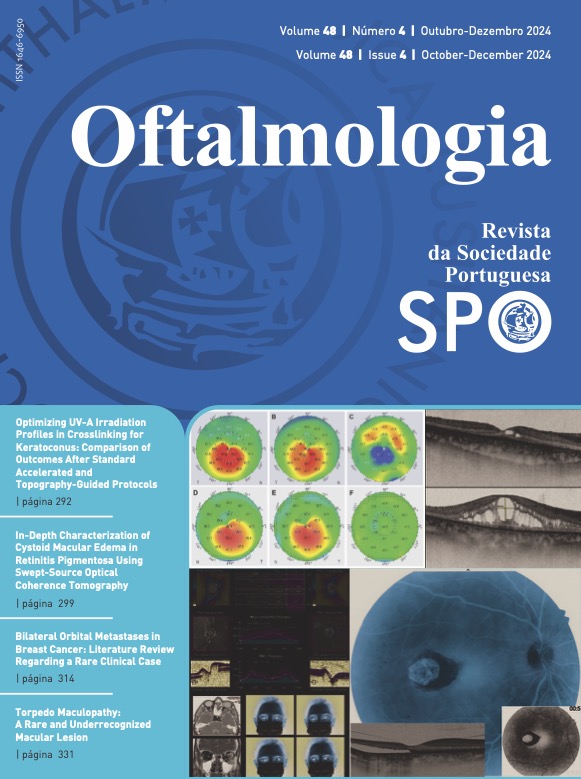Caracterização do Edema Macular Cistóide na Retinopatia Pigmentar com Recurso a Tomografia de Coerência Óptica Swept-Source
DOI:
https://doi.org/10.48560/rspo.33236Palavras-chave:
Edema Macular, Retinite Pigmentar, Tomografia de Coerência ÓpticaResumo
INTRODUÇÃO: O edema macular cistóide (EMC) pode complicar a retinopatia pigmentar (RP), contribuindo para perda de visão central. A fisiopatologia subjacente ao EMC associado à RP (EMC-RP) e o seu impacto prognóstico permanecem incertos. O objetivo foi investigar a associação entre espaços cistóides (EC), parâmetros morfométricos da retina e dados clínicos no EMC-RP, com recurso a tomografia de coerência óptica swept-source (SS-OCT).MÉTODOS: Estudo prospetivo realizado num centro de referência de distrofias hereditárias da retina (DHR) em Portugal. Doentes com RP com evidência de EMC foram recrutados do nosso centro e convidados a realizar SS-OCT (Zeiss PLEX Elite 9000). A avaliação morfométrica foi realizada por 2 avaliadores independentes (CC e CN) e incluiu: espessura da camada nuclear externa do ponto central (ECNEPC), área da zona elipsoide (AZE), espessura macular central (EMC), localização dos EC (ponto central, milímetro central, fora do milímetro central), envolvimento da camada retiniana e tamanho dos EC. Dados clínicos - sexo, idade, variantes genéticas, melhor acuidade visual corrigida (MAVC), status do cristalino e da interface vítreomacular foram registados.
RESULTADOS: Foram incluídos 40 olhos de 21 doentes (71,5% homens; idade média 47,3±15,2 anos). Em 61,90% o padrão de hereditariedade foi autossómico recessivo, 80,95% apresentavam doença não-sindrómica e 90,48% apresentavam EMC bilateral. A MAVC média foi de 68,06±14,55 letras ETDRS. EC foram encontrados na camada nuclear interna em 100% dos olhos e na camada nuclear externa em 50%. EC envolveram o ponto central ou milímetro central em 85% dos olhos (17 cada); 6 casos (15%) apresentaram EC fora do milímetro central. Tamanho e envolvimento da camada retiniana não mostraram associação com a MAVC (p=0,548 e p=0,285). EC no ponto central associaram-se a maiores AZE, quando comparados com aqueles fora do ponto central (p=0.009). AZE e ECNEPC correlacionaram-se com a MAVC (r=0.351, p=0.0286 e r=0.387, p=0.0462).
CONCLUSÃO: EC no ponto central associam-se a maiores AZE, sendo o envolvimento do ponto central ocorrente em estadios menos graves com função visual mais preservada. A correlação entre ECNEPC e MAVC destaca a importância desta camada externa na função visual no EMC-RP. Mais estudos são necessários para obter profunda compreensão desta entidade e do seu impacto na visão.
Downloads
Referências
Dias MF, Joo K, Kemp JA, Fialho SL, da Silva Cunha A Jr, Woo SJ, et al. Molecular genetics and emerging therapies for retinitis pigmentosa: Basic research and clinical perspectives. Prog Retin Eye Res. 2018;63: 107–31. doi: 10.1016/j.preteyeres.2017.10.004.
Marques JP, Carvalho AL, Henriques J, Murta JN, Saraiva J, Silva R. Design, development and deployment of a web-based interoperable registry for inherited retinal dystrophies in Portugal: the IRD-PT. Orphanet J Rare Dis. 2020;15: 304. doi: 10.1186/s13023-020-01591-6.
Marques JP, Vaz-Pereira S, Costa J, Marta A, Henriques J, Silva R. Challenges, facilitators and barriers to the adoption and use of a web-based national IRD registry: lessons learned from the IRD-PT registry. Orphanet J Rare Dis. 2022;17: 323. doi: 10.1186/s13023-022-02489-1.
Santos T, Warren LH, Santos AR, Marques IP, Kubach S, Mendes LG, et al. Swept-source OCTA quantification of capillary closure predicts ETDRS severity staging of NPDR. Br J Ophthalmol. 2022;106: 712–8. doi: 10.1136/bjophthalmol-2020-317890.
Ogino K, Oishi A, Oishi M, Gotoh N, Morooka S, Sugahara M, et al. Efficacy of column scatter plots for presenting retinitis pigmentosa phenotypes in a japanese cohort. Transl Vis Sci Technol. 2016;5: 4. doi: 10.1167/tvst.5.2.4.
Sorrentino FS, Gallenga CE, Bonifazzi C, Perri P. A challenge to the striking genotypic heterogeneity of retinitis pigmentosa: a better understanding of the pathophysiology using the newest genetic strategies. Eye. 2016;30: 1542–8. doi: 10.1038/eye.2016.197.
Bonilha VL, Rayborn ME, Bell BA, Marino MJ, Pauer GJ, Beight CD, et al. Histopathological comparison of eyes from patients with autosomal recessive retinitis pigmentosa caused by novel EYS mutations. Graefes Arch Clin Exp Ophthalmol. 2015;253: 295–305. doi: 10.1007/s00417-014-2868-z.
Hartong DT, Berson EL, Dryja TP. Retinitis pigmentosa. Lancet. 2006;368: 1795–809. doi: 10.1016/S0140-6736(06)69740-7.
Fishman GA, Maggiano JM, Fishman M. Foveal lesions seen in retinitis pigmentosa. Arch Ophthalmol. 1977;95: 1993–6. doi: 10.1001/archopht.1977.04450110087008.
Marques JP, Neves E, Geada S, Carvalho AL, Murta J, Saraiva J, et al. Frequency of cystoid macular edema and vitreomacular interface disorders in genetically solved syndromic and non-syndromic retinitis pigmentosa. Graefes Arch Clin Exp Ophthalmol. 2022;260: 2859–66. doi: 10.1007/s00417-02205649-y.
Chen C, Liu X, Peng X. Management of cystoid macular edema in retinitis pigmentosa: a systematic review and meta-analysis. Front Med. 2022;9: 895208. doi: 10.3389/fmed.2022.895208.
Bakthavatchalam M, Lai FHP, Rong SS, Ng DS, Brelen ME. Treatment of cystoid macular edema secondary to retinitis pigmentosa: a systematic review. Surv Ophthalmol. 2018;63: 329–39. doi: 10.1016/j.survophthal.2017.09.009.
Yeo JH, Kim YJ, Yoon YH. Optical coherence tomography angiography in patients with retinitis pigmentosa-associated cystoid macular edema. Retina. 2020;40: 2385–95. doi: 10.1097/IAE.0000000000002756.
Gorovoy IR, Gallagher DS, Eller AW, Mayercik VA, Friberg TR, Schuman JS. Cystoid macular edema in retinitis pigmentosa patients without associated macular thickening. Semin Ophthalmol. 2013;28: 79–83. doi: 10.3109/08820538.2012.760614.
Strong S, Liew G, Michaelides M. Retinitis pigmentosa-associated cystoid macular oedema: pathogenesis and avenues of intervention. Br J Ophthalmol. 2017;101: 31–7. doi: 10.1136/bjophthalmol-2016-309376.
Strong SA, Hirji N, Quartilho A, Kalitzeos A, Michaelides M. Retrospective cohort study exploring whether an association exists between spatial distribution of cystoid spaces in cystoid macular oedema secondary to retinitis pigmentosa and response to treatment with carbonic anhydrase inhibitors. Br J Ophthalmol. 2019;103: 233–7. doi: 10.1136/bjophthalmol-2017-311392.
Hajali M, Fishman GA, Anderson RJ. The prevalence of cystoid macular oedema in retinitis pigmentosa patients determined by optical coherence tomography. Br J Ophthalmol. 2008;92: 1065–8. doi: 10.1136/bjo.2008.138560.
Hajali M, Fishman GA. The prevalence of cystoid macular oedema on optical coherence tomography in retinitis pigmentosa patients without cystic changes on fundus examination. Eye. 2009;23: 915–9. doi: 10.1038/eye.2008.110.
Testa F, Rossi S, Colucci R, Gallo B, Di Iorio V, della Corte M, et al. Macular abnormalities in Italian patients with retinitis pigmentosa. Br J Ophthalmol. 2014;98: 946–50. doi: 10.1136/bjophthalmol-2013-304082.
Liew G, Strong S, Bradley P, Severn P, Moore AT, Webster AR, et al. Prevalence of cystoid macular oedema, epiretinal membrane and cataract in retinitis pigmentosa. Br J Ophthalmol. 2019;103: 1163–6. doi: 10.1136/bjophthalmol-2018-311964.
Richards S, Aziz N, Bale S, Bick D, Das S, Gastier-Foster J, et al. Standards and guidelines for the interpretation of sequence variants: a joint consensus recommendation of the American College of Medical Genetics and Genomics and the Association for Molecular Pathology. Genet Med. 2015;17: 405–24. doi: 10.1038/gim.2015.30.
Govetto A, Lalane RA, Sarraf D, Figueroa MS, Hubschman JP. Insights into epiretinal membranes: presence of ectopic inner foveal layers and a new optical coherence tomography staging scheme. Am J Ophthalmol. 2017;175: 99–113. doi: 10.1016/j.ajo.2016.12.006.
Bamahfouz A. Correlation of central macular thickness and the best-corrected visual acuity in three months after cataract surgery by phacoemulsification and with intraocular lens implantation. Cureus. 2021;13: e13856. doi: 10.7759/cureus.13856.
Wang P, Hu Z, Hou M, Norman PA, Chin EK, Almeida DR. Relationship between macular thickness and visual acuity n the treatment of diabetic macular edema with anti-VEGF therapy: systematic review. J Vitreoretin Dis. 2023;7: 57–64. doi: 10.1177/24741264221138722.
Lassiale S, Valamanesh F, Klein C, Hicks D, Abitbol M, Versaux-Botteri C. Changes in aquaporin-4 and Kir4.1 expression in rats with inherited retinal dystrophy. Exp Eye Res. 2016;148: 33–44. doi: 10.1016/j.exer.2016.05.010.
Mimouni M, Nahum Y, Levant A, Levant B, Weinberger D. Cystoid macular edema: a correlation between macular volumetric parameters and visual acuity. Can J Ophthalmol. 2014;49: 183–7. doi: 10.1016/j.jcjo.2013.11.004.
Arias JD, Kalaw FGP, Alex V, Yassin SH, Ferreyra H, Walker E, et al. Investigating the associations of macular edema in retinitis pigmentosa. Sci Rep. 2023;13:14187. doi: 10.1038/s41598-023-41464-z.
Ruff A, Tezel A, Tezel TH. Anatomical and functional correlates of cystic macular edema in retinitis pigmentosa. PLoS One. 2022;17: e0276629. doi: 10.1371/journal.pone.0276629.
Downloads
Publicado
Como Citar
Edição
Secção
Licença
Direitos de Autor (c) 2024 Revista Sociedade Portuguesa de Oftalmologia

Este trabalho encontra-se publicado com a Creative Commons Atribuição-NãoComercial 4.0.
Não se esqueça de fazer o download do ficheiro da Declaração de Responsabilidade Autoral e Autorização para Publicação e de Conflito de Interesses
O artigo apenas poderá ser submetido com esse dois documentos.
Para obter o ficheiro da Declaração de Responsabilidade Autoral, clique aqui
Para obter o ficheiro de Conflito de Interesses, clique aqui





